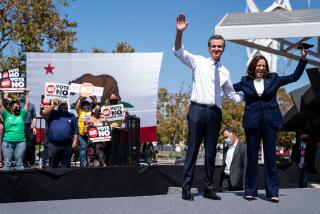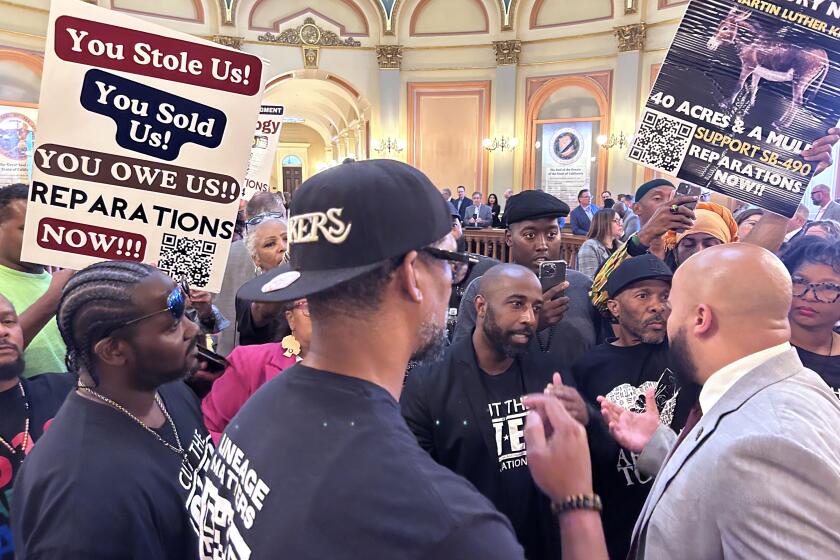<i> Snapshots of life in the Golden State.</i> : Tsongas Has Card to Play in California’s Primary
- Share via
Although he bowed out of the presidential race last month, former U.S. Sen. Paul E. Tsongas could still play a key role in California’s June 2 Democratic presidential primary.
That is because the economically conservative Massachusetts politician did not file an affidavit to withdraw his name from the ballot before last week’s deadline. He said Sunday in Washington that he may re-enter the race depending on how well he does--and how well Arkansas Gov. Bill Clinton does--in Tuesday’s New York primary. Supporters aired ads to remind people that he is on the ballot there.
Last month, after having suspended his candidacy, Tsongas nonetheless drew 20% of the vote in Connecticut, possibly throwing the primary to former California Gov. Edmund G. (Jerry) Brown Jr. And if Brown and Clinton batter each other beyond repair in their two-man shootout, Tsongas still has the option of reactivating his candidacy in California.
In all, seven candidates will be on the California ballot, in the order determined by a random drawing by the secretary of state’s office: former Irvine Mayor Larry Agran, Clinton, former U.S. Sen. Eugene J. McCarthy, U.S. Sen. Bob Kerrey (who also failed to withdraw his name after quitting the race), Brown, political extremist Lyndon LaRouche Jr. (who is serving a 15-year federal prison sentence for fraud and tax evasion) and Tsongas.
LaRouche’s name was ordered on the ballot by a Sacramento Superior Court judge after LaRouche filed a lawsuit.
On the Republican side, conservative commentator Patrick J. Buchanan, having won a rare victory over George Bush (in the state’s random drawing), will be listed ahead of the President.
POLITICAL INSIDER
Spell check: In its latest issue, the California Journal ranks Sacramento legislators in such categories as integrity, effectiveness, energy and smarts.
In two charts, the bookish monthly also rates legislators’ “Intellegence,” presumably meaning intelligence. There was no chart rating the intelligence of political journals when it comes to spelling.
For the record, the Journal’s survey ranks Sen. Quentin L. Kopp (I-San Francisco) and Assembly Speaker Willie Brown (D-San Francisco) as the state’s smartest legislators. Scoring the lowest for intelligence were Sen. Bill Greene (D-Los Angeles) and Assemblyman Willard H. Murray Jr. (D-Paramount).
No. 1 in overall rankings were Sen. Patrick Johnston (D-Stockton) and Assemblyman Phillip Isenberg (D-Sacramento).
Like son, like father: The big winners in Rep. Mel Levine’s campaign for U.S. Senate could be California’s broadcasters, who will take in more than $3 million for running his TV ads.
Another winner--albeit smaller--is the state’s Democratic Party, which has attracted at least one longtime Republican as a result of Levine’s candidacy--his father Sid, a longtime GOP fund-raiser.
The elder Levine disclosed last week that he has switched his allegiance to the Democratic Party to vote for his son in the June primary. Speaking at one of his son’s fund-raisers, Levine also insisted that his move was a protest against the direction of the Republican Party.
Puffing Less
Cigarette smoking in California has been declining for more than a decade, according to figures compiled by the state Board of Equalization. The figures below represent the average number of packs of cigarettes smoked per individual Californian in the last 10 years. (These per-capita consumption figures are based on the total state population, both smokers and nonsmokers.)
Fiscal Year & Number Of Packages
1990-91: 72.3
1989-90: 78.4
1988-89: 84.7
1987-88: 94.9
1986-87: 98.4
1985-86: 102.3
1984-85: 106.7
1983-84: 109.9
1982-83: 115.8
1981-82: 120.4
1980-81: 123.6
Source: California State Board of Equalization Statistics Division, Sacramento
Compiled by researcher Tracy Thomas
ON CAMPUS
F for fire: In an effort to prevent future fire disasters, UC Berkeley is offering a mechanical engineering course aimed at uncovering the cause of the devastating 1991 Oakland hills inferno.
Dubbed “Case Studies in Fire Safety Engineering Science,” the 10-student graduate class includes field trips to the fire zone and a study of videotapes of the blaze that left 25 people dead and gutted more than 3,000 structures in the vicinity of the East Bay campus.
At a symposium next month, students will present their findings on how the fire affected paint, shingles and window panes, and on how meteorological conditions and hillside vegetation may have contributed to the intensity of the blaze.
EXIT LINE
“With about one-fourth of the federal aerospace budget going into California, there is an economically hazardous reliance on Washington funding.”
-- Neil Morgan, in his 1969 book “The California Syndrome.”
More to Read
Get the L.A. Times Politics newsletter
Deeply reported insights into legislation, politics and policy from Sacramento, Washington and beyond. In your inbox twice per week.
You may occasionally receive promotional content from the Los Angeles Times.










